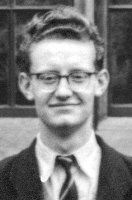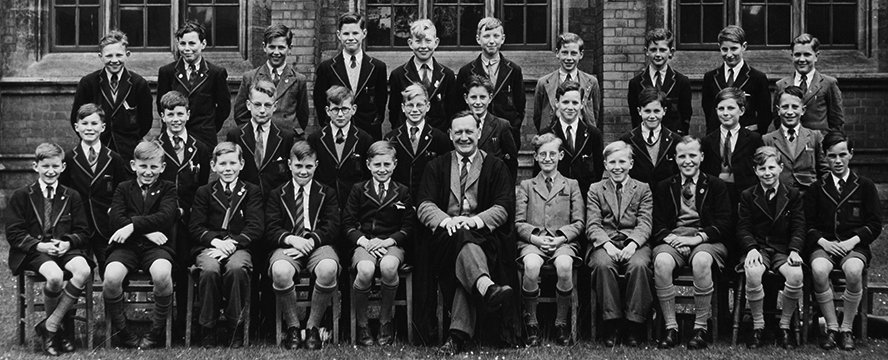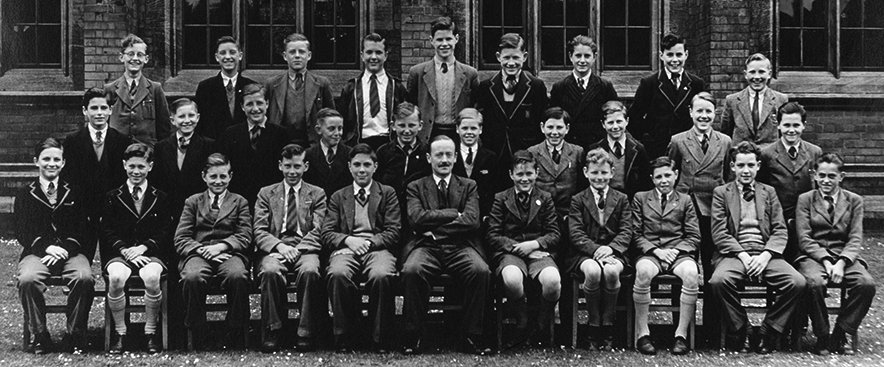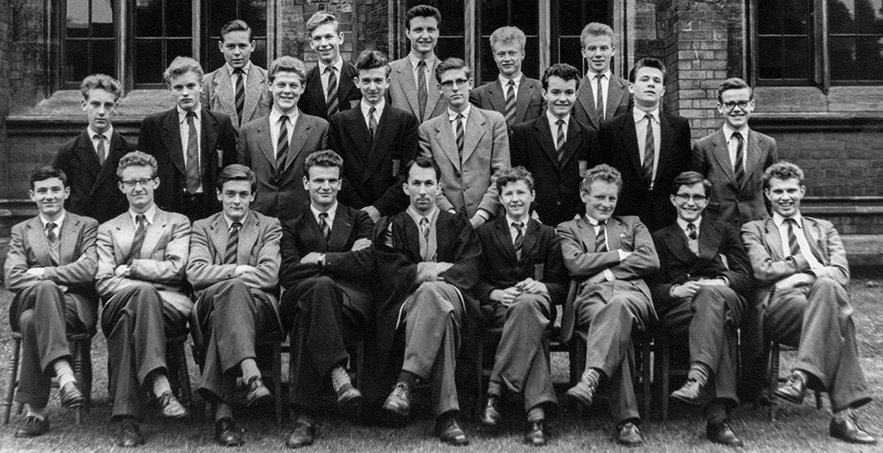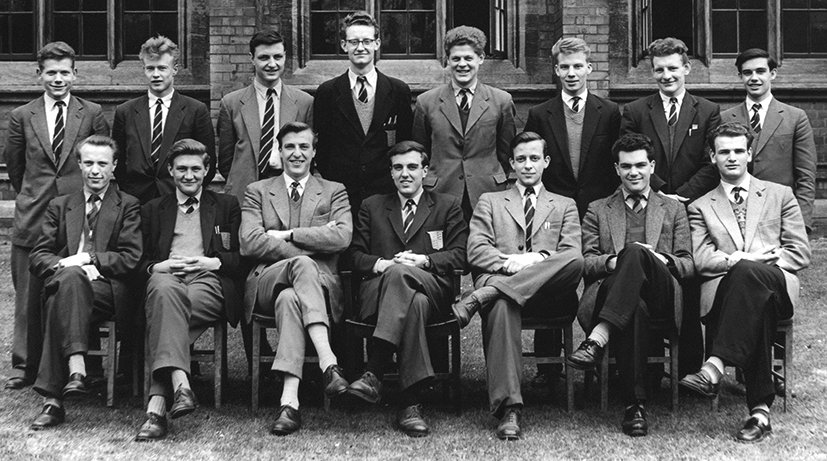Memories of Retford Grammar School
Ian McIntosh 1951-1959
|
July 1951 saw my departure from Bircotes Junior School for a summer
holiday in which to prepare for the next stage in my education. School
uniform had to be bought from the only supplier, Loseby’s of Retford and
Worksop. We were still in the era of post-war austerity and although
clothes rationing had ended, things were still not fully back to normal,
so the only compulsory items seemed to be a school cap (dark green with
red braid stripes radiating from the crown) and a school tie with red and
green stripes and I think a blazer was desirable but not yet compulsory.
In our area, the place for a school satchel was Frost’s the saddlers in
Bawtry. Their window display was a riot of colour, showing the jockey’s
silks in preparation for the racing at Doncaster. The most striking
impression on entering the shop was a strong, glorious smell of leather,
then the sight of saddles and other horsey bits and pieces. My parents
chose a simple (i.e. affordable) satchel with single shoulder strap and
front pocket and two buckles to fasten the flap. Price £2/10s if I remember
aright.
There were about six of us from our junior school on the bus to Retford,
plus others we knew, who were in higher forms. Of course we had all been
told of the horrible initiation ceremonies which awaited us as “New Boys” -
heads pushed down the lavatory and the chain pulled etc. etc… Needless to
say, none of these horrors turned out to be true, at least in my experience.
The older boys seemed more intent on catching up on their holiday gossip
and playing ball games on the field, than on tormenting “sprogs.” They
scarcely gave us more than a curious glance.
We were lined up in front of the main entrance beneath the Belfry and
split into two forms alphabetically. The A to J surnames were in 1J and
the K to Zs were in 1K and were treated as parallel forms. I believe that
this was the first year for this arrangement and it seemed to confuse some
of the well-established masters. I was in 1K (as was our esteemed webmaster
here!) and our form master was Mr. E.C. Charlton who was a stickler for
high standards of behaviour and stood no nonsense. In the classroom we were
seated in alphabetical order starting on the back row, left-hand side. I
remember the order now. Kemp, Kirk, Lake, McIntosh, Massey, Milburn, Mokes,
Morris, Morris …
Many of our lessons were held in our own form-room on the New Block, some
in specialist rooms.
History with Mr. Charlton. aka “Charlie” or “Bull” or “Mizza” -
The Old Stone Age, and on from there!
English with Mr. Hunter.
Superb graphic artist who drew wonderful, humorous illustrations of
scenes from the poems we were reading. I recall, from the Pied Piper of
Hamelin, his drawing of the obese Mayor and his Corporation, showing the
two meanings of “corporation.” He left to take up a post in Northumberland
and we then had Mr. Charlton.
Science with Mr. Wilson.
For this we went to the Chemistry Lab. which seemed half underground, the
high windows being at pavement level. One of our first practical lessons
was to plot a cooling curve for paraffin wax (or was it naphthalene?)
In one lesson, when we were sitting crowded around the teacher’s bench on
lab. stools and side benches, one boy (D.M.S. I think) was obviously
fascinated by the form of the laboratory taps, which were tall and had
narrow tapering spouts. I watched him with growing disbelief as he slowly
rotated the tap until the outlet was pointing up in the air. Then,
following his own unofficial line of enquiry, he tried to turn the tap on -
as it was stiff, he tried harder and suddenly to his and everyone else’s
horror a forceful jet of water shot into the air and landed on and between
the seated boys. Minor chaos followed but calm was quickly restored. I
think the master realized that no malice was intended!
Maths with Mr. J.D. Illingworth aka “Tash.” Always interesting. I can see
now his diagrams illustrating the proofs of various geometric laws. We had
to be quick to assess his “mood” as he could be jovial and jokey for the
most part but morose and punitive on occasions. He was also our Latin master
but for the first few weeks of the Autumn term we went to the Albert Street
baths for swimming lessons, until they closed for the winter season. We ran
to the baths chasing after Tash on his battered old bike which he told us
was a “Rolls Canardly”. It rolls down one hill and can ‘ardly get up the
next! When Latin lessons did start, it was a nightmare for me. I really did
not get the hang of it at all. Now, having learnt a little Spanish, I wish
we had started with that modern language and then moved on to Latin, it
would have been so much easier.
As a complete aside, Mr Illingworth had a son at the school, Paul who was
an excellent swimmer and diver. Years later I met him in Norfolk where he
was Rector of Weston Longville church and he told me that “Tash” was still
alive and well into his eighties. All that cigarette smoke must have
preserved him!
Religious Education with Mr. Holman aka “Sandy.” I don’t remember much
about the lessons except that he expected quite long essays about things
which the writers of the Authorised Version managed to express in a handful
of verses!
P.E. and Geography with Mr. H. Brooke. I was utterly hopeless at almost all
aspects of gym work and sport in general. When shown how to vault over the
“Box,” I ran at it full tilt and head-butted it instead of doing a
somersault over it.
Games with Mr. Charlton. We had to walk from school, down Dominie Cross road
past the Sir Frederick Milner secondary school to the school playing field.
Here we played football on a sloping pitch, with the master in his robust
trench coat looking on.
French with Mr. Chislett. I got on with French much better than Latin.
Art with Mr. Penrose. I quite liked Art and was reasonably good at it.
I always seemed to get the same mark term after term, 54%!
Music with Mr. Gooder. I really enjoyed music lessons in school although
I did not play an instrument as many of the boys did - some with quite
advanced piano grades under their belts.
The usual daily ritual started with the first bell when we had to line up
outside the hall for assembly. We stood in rows according to form under
the ever watchful eye of Rev. MacFarran who was ferocious with anyone who
transgressed. The Head would enter majestically, address the school,
announce the hymn and the reading and have the whole thing over quite
speedily. Then came registration and on to lesson time. There were seven
lesson periods per day, two before morning break, then two after. Lunch
time was from 12.35 to 13.50 and there were two sittings for lunch.
(Speaking of which, the lunches at school were superb, except for the day
when the gas works blew up and the school meals staff had to try to cook
something up on Mrs. Gover’s AGA.)
The trestle tables were arranged lengthways with a “Dinner Prefect” at each
end and eight boys on forms along the side. There was a rota whereby every
so many weeks, your table had to act as ‘servers’ for all the tables in
the other sitting for a week. The scheme was administered by ‘Mac’ - Rev.
MacFarran. The prized allocation was to serve the masters’ table as they
sometimes left a small tip! (Or so I was told. Such luck never came my way.)
After afternoon registration, there were three more lessons and school ended
at 4.10p.m.
After school, on Wednesdays and Fridays was the dreaded DETENTION.
Miscreants were sent to the office to, “Bring me the detention book, boy.”
The head read out the list in assembly by way of shaming the guilty.
Detention was held in “The Dormitory,” a name lingering from a time when
the school had in-house boarders. It ended at 5.15pm and one had to rush
to get the bus from Cannon Square by 5.35. If a master on duty was slow
to end the detention session, it could be 7.00pm before one got home. I
thought it most unfair on those not living in Retford.
Punishments meted out by masters, varied from copying out the school rules -
Prefects have absolute authority over all questions of discipline. etc.
- to writing lines (paper provided by all but Mr. Charlton - “I don’t care
if you write it on sugar bags, laddie.”
- detention (see above)
- Saturday morning detention (almost the nuclear deterrent)
- caning (officially only by the head and deputy, but got round by masters
who used a slipper, or “Tash” who used the “Bacon Slicer,” a chop across
the buttocks with the edge of a ruler. Painful and left little evidence!
Prefects also gave out lines and in my early days they had a lunchtime
detention. Their uniform was distinguishable from the others as the cap was
plain dark green with a silken tassel hanging from the crown rather in the
manner of the mortarboard.
As new boys, we had to learn the ropes, such as keeping to the one-way
system, raising the peak of one’s cap on seeing a master in town or
doffing the cap completely if seeing Mrs. Gover cycling to or from home.
As I remember it, my school life for the first few years was filled with
fear. There was fun, of course, and the pleasure at mastering new things
and making new friendships.
During lunchtime we were allowed out into the town and often went across
the road (the A1) to Mrs. Smedley’s shop for a glass of ‘pop’ where she
would mix bizarre concoctions of various mineral waters such as dandelion
and burdock with cherryade with a splash of limeade - whatever ridiculous
recipe we came up with - all for 2½d. She also sold old fashioned pen nibs
of an amazing variety - severely angled ones for left-handers - ones with
five points, for ruling music manuscripts!
Woolworths was an attraction too as was the “Paper Bag Shop,” just behind
the town hall.
As new boys, some of us had little idea about those assumed norms of how
things were done. One incident illustrates this naïveté . It was announced
that we were to have the afternoon off to go to the playing field to watch
the school football team play against another school and as we were not
remotely interested in football, I, together with two class-mates decided
to go off to the town until bus time. We did not regard this as sneaking
off and were quite open about our tour of Retford. Just as we were entering
Woolworths, who should we see coming out but our form master. We greeted
him politely with the usual tip of the cap and continued on our way
untroubled. However ...
...there was trouble, and it lasted for years! We seemed never to hear the
last of it and it took me a long to redeem myself in that master’s eyes.
He later held me up as a paragon of virtue for volunteering to enter more
events in the House sports “Standard Tests.”
The latter were athletic tests for which points were gained according to
times/distances recorded relative to age. No matter how poor you were you
could gain a point even for running 100 yards quite slowly. The more events
you entered, the more points you clocked up. These points were added to
those on Sports Day to decide the winning house. The pressure was on
everyone to take part, even the dud runners and throwers, like me!
End of Part One.
Ian McIntosh June 2013
|
